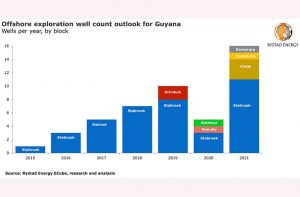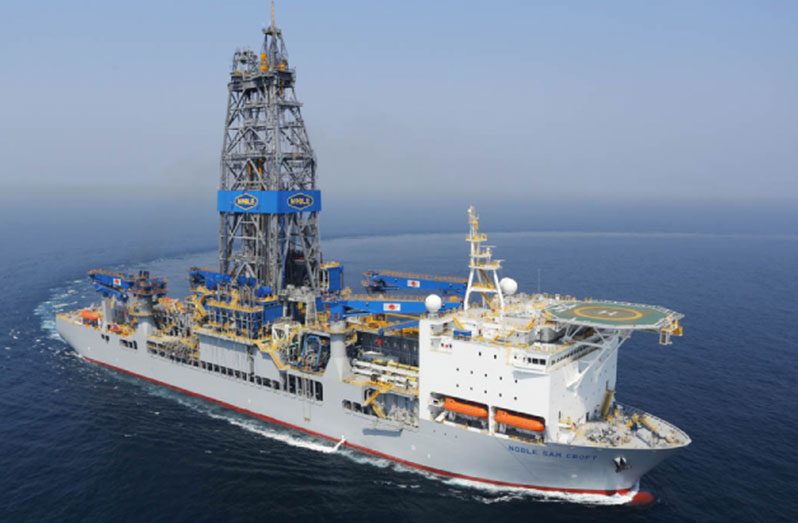–with 16 exploration wells planned
–each discovery so far holds on average 300M barrels of oil equivalent, says Rystad
WITH 16 exploration wells planned for this year, Norwegian independent energy research and business intelligence firm, Rystad Energy, has said that 2021 holds “a lot of promise” for Guyana’s burgeoning petroleum sector.
Oil giant, ExxonMobil, operator of the Stabroek, Canje and Kaieteur blocks offshore Guyana will be spearheading the local exploration activities, having already set an ambitious divestment target of $15 billion by expelling mature assets in Asia, Europe and Africa, so as to prioritise investments in “high-value” assets such as Stabroek. According to Rystad Energy, the company’s drilling activity will focus on “firming up” resources in the southeastern part of the Stabroek Block, where deeper plays have been observed underneath the existing discoveries.
The Stabroek Block is 6.6 million acres (26,800 square kilometers), with current discovered recoverable resources estimated at more than nine billion oil-equivalent barrels. The 18 discoveries on the block to date have established the potential for at least five floating production, storage and offloading (FPSO) vessels producing more than 750,000 barrels of oil per day by 2026.

ExxonMobil’s first offshore Guyana project, Liza Phase One, began producing in late 2019, well ahead of the industry average for development time. Liza Phase Two remains on track to begin producing oil by early 2022.
Liza Phase Two will produce up to 220,000 barrels of oil per day at peak rates, using the Liza Unity FPSO.
Recently, the oil giant, following an agreement with the Government of Guyana, decided to proceed with the Payara field development offshore Guyana.
Payara is ExxonMobil’s third project in the Stabroek Block, and is expected to produce up to 220,000 barrels of oil per day, after start-up in 2024, using the FPSO vessel. The US$9 billion development will target an estimated resource base of about 600 million oil-equivalent barrels.
“Rystad Energy data suggests that close to 300 million barrels of oil equivalent has been discovered on average for each exploration well (wildcat and appraisal) drilled in the country over the past six years,” Analyst attached to Rystad Energy’s upstream team, Santosh Kumar, said in a recent report.
This aside, with around 16 exploration wells planned, including some in riskier frontier regions, 2021 holds a lot of promise, Kumar said. And, not only is ExxonMobil “firming up” resources in the southeastern part of the Stabroek block, it is also eyeing the unexplored northwestern parts of the block. In addition, work is also lined up for the Canje Block.
The year’s first completed well, Bulletwood-1, in the Canje block, encountered quality reservoirs but non-commercial hydrocarbons, according to Westmount Energy, which holds a stake in Canje partner JHI Associates.
The well was targetting more than 500 million barrels of mean prospective resources in a prospect similar to Liza in the neighboring Stabroek block. On the Canje block, plans are in place to drill two wells in 2021 in addition to the non-commercial Bulletwood-1 find, with the Jabillo-1 well already in progress.
The Stena DrillMAX arrived recently and initiated drilling activities on the Longtail-2 appraisal well, while the Stena Carron drillship, which recently concluded drilling Bulletwood-1, has spudded the Jabillo-1 exploration well in the Canje block. The oil company and its partners plan to deploy four FPSO vessels to develop the existing resources within the block.
MORE DRILL SHIPS
Additionally, according to Rystad Energy, ExxonMobil’s fleet of contracted drill ships in Guyana is set to increase to six with the arrival of the Noble Sam Croft in April, 2021. The company is expected to ramp up drilling activities, as it plans to have at least five FPSO vessels online by 2026.
Rystad believes that drilling results will be eagerly watched by the services industry, as more exploration success off Guyana would translate into welcomed opportunities after the market slump of 2020.
The country’s oil-and-gas-sector is already pumping finances into its Natural Resources Fund (NRF), with some US$61,090,968 (approximately G$13B) being earned from the sale of the nation’s fifth oil lift. The Government, in keeping with its commitment to accountability and transparency in the petroleum sector, has announced that the country received its latest payment after the sale of 997,420 barrels of oil which were lifted from ExxonMobil’s Liza Destiny on February 5, 2021.
The nation, new to the petroleum sector, sold its first one million barrels of crude on February 19, 2020, raking in nearly US$55 million. In its second million-barrel sale, the country received US$35 million, US$46 million as proceeds from the sale of its third million-barrel of crude, and US$49.3 million from its fourth oil lift.
Based on a consolidation of all the lifts to date, the country has sold 5,009,797 barrels of oil valuing US$246,542,662.
Along with the earnings from the oil lifts and over US$21 million in royalties and interest, Guyana has close to US$267,668,709 in its NRF, at the U.S. Federal Reserve Bank. Under the Production Sharing Agreement (PSA), Guyana receives two per cent royalty and 50 per cent profit oil, which is what remains after the producer recovers the production cost.




.png)









